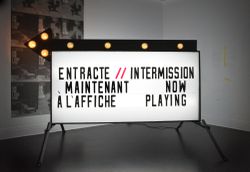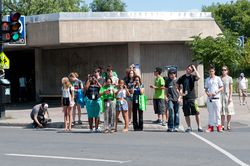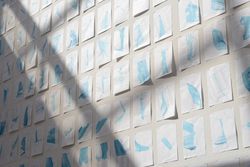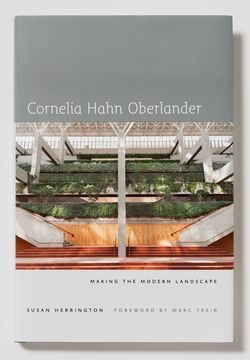Les galeries du CCA sont transformées en salles de projection cinématographique afin de présenter une gamme de films artistiques, scientifiques et expérimentaux traitant des thèmes de la vitesse et de l’espace. Choisis par des commissaires à même les archives de la NASA, de l’Office national du film du Canada (ONF), du Musée national de l’air et de l’espace de la(...)
Salles principales
25 novembre 2009 au 28 février 2010
Entracte : Films d'un futur héroïque
Actions:
Description:
Les galeries du CCA sont transformées en salles de projection cinématographique afin de présenter une gamme de films artistiques, scientifiques et expérimentaux traitant des thèmes de la vitesse et de l’espace. Choisis par des commissaires à même les archives de la NASA, de l’Office national du film du Canada (ONF), du Musée national de l’air et de l’espace de la(...)
Salles principales
Projet
AP178.S1.1995.PR07
Description:
This project series documents the Renovação e extensão do Museu Stedelijk in Amsterdam, The Netherlands. While the records were held in the office’s archives this project was assigned the number 57/90. The office assigned the date 1995 to this project. At the beginning of the nineties, Rem Koolhaas, Wim Quist, Carel Weeber, and Robert Venturi were invited to propose a design for the extension and renovations of the Stedelijk Museum. Robert Venturi was the architect selected, but the project was suspended in 1993 due to the infeasibility of the program and budget restrictions. The following year, five applicants, including Siza, were asked to present a new design to a committee. In December 1995, Siza was officially announced as the new design architect for the project by the city of Amsterdam. The firm A+D+P was selected as the executive architect. Siza's first proposal was presented in 1998. His master plan included the demolition of the Marmottenhuis, the renovation of the 19th-century patios, and the relocation of the public toilets to the basement in order to create exhibition halls. The master plan also included the construction of three new wings and two underground passages to connect the newer and older buildings. A new wing, located to one side of Sandbergplein, included offices in the basement and on the ground floor as well as exhibition halls on the first floor. A new building surrounding the museum garden included storage space in the basement, a restaurant on the ground floor, and exhibition halls at the first floor. Construction work was projected to start in June 2000, however due to budget restrictions the project was not realized and a new competition was held in 2004. The firm Benthem Crouwel Architects realized the project. Documenting this project are sketches, studies, preliminary drawings, plans, and working drawings. Textual materials include project documentation and correspondence. Photographic materials document the models and project site.
1989-2002
Renovação e extensão do Museu Stedelijk [Restoration and extension of Stedelijk Museum], Amsterdam, The Netherlands (1995)
Actions:
AP178.S1.1995.PR07
Description:
This project series documents the Renovação e extensão do Museu Stedelijk in Amsterdam, The Netherlands. While the records were held in the office’s archives this project was assigned the number 57/90. The office assigned the date 1995 to this project. At the beginning of the nineties, Rem Koolhaas, Wim Quist, Carel Weeber, and Robert Venturi were invited to propose a design for the extension and renovations of the Stedelijk Museum. Robert Venturi was the architect selected, but the project was suspended in 1993 due to the infeasibility of the program and budget restrictions. The following year, five applicants, including Siza, were asked to present a new design to a committee. In December 1995, Siza was officially announced as the new design architect for the project by the city of Amsterdam. The firm A+D+P was selected as the executive architect. Siza's first proposal was presented in 1998. His master plan included the demolition of the Marmottenhuis, the renovation of the 19th-century patios, and the relocation of the public toilets to the basement in order to create exhibition halls. The master plan also included the construction of three new wings and two underground passages to connect the newer and older buildings. A new wing, located to one side of Sandbergplein, included offices in the basement and on the ground floor as well as exhibition halls on the first floor. A new building surrounding the museum garden included storage space in the basement, a restaurant on the ground floor, and exhibition halls at the first floor. Construction work was projected to start in June 2000, however due to budget restrictions the project was not realized and a new competition was held in 2004. The firm Benthem Crouwel Architects realized the project. Documenting this project are sketches, studies, preliminary drawings, plans, and working drawings. Textual materials include project documentation and correspondence. Photographic materials document the models and project site.
Project
1989-2002
archives
Niveau de description archivistique:
Fonds
AP051
Résumé:
The Groupe de recherche sur Montréal fonds, 1975-1997, documents the Groupe de recherche sur Montréal’s (GRM) extensive research on the development of pre and post-industrial Montreal’s built environment. In addition to this extensive collection of research materials, the fonds also includes administrative files relating to the GRM’s everyday administration and management. Materials found in this fonds consist of approximately 40 l.m. of textual documentation, approximately 2000 maps and 1 model.
1975-1997
Fonds Groupe de recherche sur Montréal
Actions:
AP051
Résumé:
The Groupe de recherche sur Montréal fonds, 1975-1997, documents the Groupe de recherche sur Montréal’s (GRM) extensive research on the development of pre and post-industrial Montreal’s built environment. In addition to this extensive collection of research materials, the fonds also includes administrative files relating to the GRM’s everyday administration and management. Materials found in this fonds consist of approximately 40 l.m. of textual documentation, approximately 2000 maps and 1 model.
archives
Niveau de description archivistique:
Fonds
1975-1997
Projet
AP178.S1.1968.PR02
Description:
This project series documents the Edifício de Escritórios na Av. D. Afonso Henriques, in Porto, also referred to as Avenida da Ponte I. While the records were held in the office’s archives this project was assigned the number 31/60. In the past the office identified the project as number 121. The office assigned the dates 1968-1974 for this project. The Edifício de Escritórios na Av. D. Afonso Henriques consisted of a building with offices, stores, and parking. Located on a historic site, the intention for the Edifício de Escritórios was to integrate the building into the existing urban landscape. The building was never realized. This project was done in relation to the Arranjo Urbanístico para a Av. D. Afonso Henriques, which was an urban renewal program in Porto. In the 1940s, waves of demolition in the old town created a rupture with the remaining buildings, including the Porto Cathedral. Since the 1950s, there have been several studies and proposals to revitalize this part of the city. Siza’s plan was the first to be accepted by the city council in 1968. Please see project series AP178.S1.1968.PR03, also described in this fonds, for further documentation. Siza also proposed a new design in 2001 for the site across the avenue from this one, known as Avenida da Ponte II. This included a museum, library, stores, parking, and houses. This project related to the building Casa Dos 24 Fernando Távora. The scheme was not realized. Documenting this project series are drawings, photographic materials and textual documentation. Among the drawings are plans, profiles, elevations, sections, cadastral maps and working details. Photographic materials document the model, site and residents of the neighborhood. Textual materials include project documentation, as well as correspondence with the city of Porto and suppliers. Note that materials related to the Arranjo Urbanístico para a Av. D. Afonso Henriques (project series AP178.S1.1968.PR03 in this fonds) are also found among these materials.
1968-1981
Edifício de Escritórios na Av. D. Afonso Henriques, Avenida da Ponte [Office building, Av. D. Afonso Henriques], Porto, Portugal (1968-1981)
Actions:
AP178.S1.1968.PR02
Description:
This project series documents the Edifício de Escritórios na Av. D. Afonso Henriques, in Porto, also referred to as Avenida da Ponte I. While the records were held in the office’s archives this project was assigned the number 31/60. In the past the office identified the project as number 121. The office assigned the dates 1968-1974 for this project. The Edifício de Escritórios na Av. D. Afonso Henriques consisted of a building with offices, stores, and parking. Located on a historic site, the intention for the Edifício de Escritórios was to integrate the building into the existing urban landscape. The building was never realized. This project was done in relation to the Arranjo Urbanístico para a Av. D. Afonso Henriques, which was an urban renewal program in Porto. In the 1940s, waves of demolition in the old town created a rupture with the remaining buildings, including the Porto Cathedral. Since the 1950s, there have been several studies and proposals to revitalize this part of the city. Siza’s plan was the first to be accepted by the city council in 1968. Please see project series AP178.S1.1968.PR03, also described in this fonds, for further documentation. Siza also proposed a new design in 2001 for the site across the avenue from this one, known as Avenida da Ponte II. This included a museum, library, stores, parking, and houses. This project related to the building Casa Dos 24 Fernando Távora. The scheme was not realized. Documenting this project series are drawings, photographic materials and textual documentation. Among the drawings are plans, profiles, elevations, sections, cadastral maps and working details. Photographic materials document the model, site and residents of the neighborhood. Textual materials include project documentation, as well as correspondence with the city of Porto and suppliers. Note that materials related to the Arranjo Urbanístico para a Av. D. Afonso Henriques (project series AP178.S1.1968.PR03 in this fonds) are also found among these materials.
Project
1968-1981
La non-école
À quoi pourrait ressembler l’école? C’est la question qu’a posée aux étudiants notre conservatrice invitée, Monica Nouwens, au cours du cinquième Camp de jour. Pendant une semaine durant l’été de 2012, les étudiants de La non-école ont exploré les espaces intérieurs et environnants de quelques écoles, et ils ont repoussé les limites de l’appareil photo utilisé comme(...)
30 juillet 2012 au 3 août 2012
La non-école
Actions:
Description:
À quoi pourrait ressembler l’école? C’est la question qu’a posée aux étudiants notre conservatrice invitée, Monica Nouwens, au cours du cinquième Camp de jour. Pendant une semaine durant l’été de 2012, les étudiants de La non-école ont exploré les espaces intérieurs et environnants de quelques écoles, et ils ont repoussé les limites de l’appareil photo utilisé comme(...)
Quand Gordon Matta-Clark se procure les titres de propriété et la documentation d’une douzaine de petites parcelles non occupées à New York entre 1974 et 1977 (qui, en 1992, ont fait l’objet d’une exposition intitulée Reality Properties: Fake Estates), il n’a pas d’intention précise – autre que sa conviction suivant laquelle « l’existence de lots vacants et sous-utilisés(...)
Théâtre Paul-Desmarais
22 septembre 2016, 18h
Nicholas de Monchaux : Local Code
Actions:
Description:
Quand Gordon Matta-Clark se procure les titres de propriété et la documentation d’une douzaine de petites parcelles non occupées à New York entre 1974 et 1977 (qui, en 1992, ont fait l’objet d’une exposition intitulée Reality Properties: Fake Estates), il n’a pas d’intention précise – autre que sa conviction suivant laquelle « l’existence de lots vacants et sous-utilisés(...)
Théâtre Paul-Desmarais
Projet
AP194.S1.1995.PR01
Description:
Project records consist of records documenting the three phases of the Synthetic Landscape project (1995-2000) as worked on by Johan Bettum and OCEAN North. The project was initially developed and submitted in 1995 for the Membrane Design International Competition held in Japan by the Taiyo Kogyo Corporation. The entry showcases a children’s playscape in the setting of Oslo’s Tøyen Park, joining both its urban surroundings and its natural landscape into a synthetic space. Afterwards, the project was exhibited at the Architecture Association (AA) in London, where Johan Bettum and Kivi Sotamaa met. This eventually led to Bettum and Sotamaa collaborating on projects, along with their respective OCEAN teams in Oslo and Helsinki. The Synthetic Landscape project continued as a research project, with a second phase in 1996 and a third phase which ran from 1997 through 2000 and integrated design methods (particle streaming, Channelling Systems) from the work made on the Töölö and Jyväskylä projects. In the third phase, a pavilion was also added to the setting. Aside from one drawing, all records for this project are in a digital format. Drawings and models from phase 1 show parts or the whole of a shell-like structure. A color scheme seems to be associated to the different components of the structure. A report on phases 1 and 2 discusses the use of synthetic and composite materials for the structure, explaining the concept for the site. Phase 2 textual records include a working plan, site charts and program. Additional drawings and models show an evolution in the shape of the landscape. Most records are related to the third phase of Synthetic Landscape. They are largely drawings and models showing textures and coloured grafts used in the design process, section and surfaces studies, as well as site plans. Other files of the third phase consist of animated renderings of Channelling Systems studies within the Synthetic Landscape topology, saved as Quicktime MOV files. Additionally, the third phase of Synthetic Landscape has files related to the FEM (finite element method) analysis process utilized in the project’s engineering. This particular section includes raster images showing vectorial drawings and data appearing to be surface studies. These were likely created with the software Mathematica. The bulk of textual documentation on the project’s scope and outcomes may be found in AP194.S1.1995.PR01.001 for phases 1 and 2, and in AP194.S1.1995.PR01.005 for phase 3. The latter file also contains documentation related to a grant application to The Research Council of Norway; a proposal for a conference and exhibition at the AA; and administrative records such as budgets, correspondence, invoices, progress reports, meeting agendas and minutes. For all project phases, records related to the design process consist of CAD models saved in a variety of modelling formats (iges, fmz, dgn, 3dm, dxf) as well as raster or vector images (tiff, jpeg, png, eps, pict, etc.). In some cases, only these raster or vector images of the original CAD drawings are present in the archive.
1995-2000
Synthetic Landscape research project, Oslo, Norway (1995-2000)
Actions:
AP194.S1.1995.PR01
Description:
Project records consist of records documenting the three phases of the Synthetic Landscape project (1995-2000) as worked on by Johan Bettum and OCEAN North. The project was initially developed and submitted in 1995 for the Membrane Design International Competition held in Japan by the Taiyo Kogyo Corporation. The entry showcases a children’s playscape in the setting of Oslo’s Tøyen Park, joining both its urban surroundings and its natural landscape into a synthetic space. Afterwards, the project was exhibited at the Architecture Association (AA) in London, where Johan Bettum and Kivi Sotamaa met. This eventually led to Bettum and Sotamaa collaborating on projects, along with their respective OCEAN teams in Oslo and Helsinki. The Synthetic Landscape project continued as a research project, with a second phase in 1996 and a third phase which ran from 1997 through 2000 and integrated design methods (particle streaming, Channelling Systems) from the work made on the Töölö and Jyväskylä projects. In the third phase, a pavilion was also added to the setting. Aside from one drawing, all records for this project are in a digital format. Drawings and models from phase 1 show parts or the whole of a shell-like structure. A color scheme seems to be associated to the different components of the structure. A report on phases 1 and 2 discusses the use of synthetic and composite materials for the structure, explaining the concept for the site. Phase 2 textual records include a working plan, site charts and program. Additional drawings and models show an evolution in the shape of the landscape. Most records are related to the third phase of Synthetic Landscape. They are largely drawings and models showing textures and coloured grafts used in the design process, section and surfaces studies, as well as site plans. Other files of the third phase consist of animated renderings of Channelling Systems studies within the Synthetic Landscape topology, saved as Quicktime MOV files. Additionally, the third phase of Synthetic Landscape has files related to the FEM (finite element method) analysis process utilized in the project’s engineering. This particular section includes raster images showing vectorial drawings and data appearing to be surface studies. These were likely created with the software Mathematica. The bulk of textual documentation on the project’s scope and outcomes may be found in AP194.S1.1995.PR01.001 for phases 1 and 2, and in AP194.S1.1995.PR01.005 for phase 3. The latter file also contains documentation related to a grant application to The Research Council of Norway; a proposal for a conference and exhibition at the AA; and administrative records such as budgets, correspondence, invoices, progress reports, meeting agendas and minutes. For all project phases, records related to the design process consist of CAD models saved in a variety of modelling formats (iges, fmz, dgn, 3dm, dxf) as well as raster or vector images (tiff, jpeg, png, eps, pict, etc.). In some cases, only these raster or vector images of the original CAD drawings are present in the archive.
Project
1995-2000
Première biographie de l’une des architectes de paysage les plus influentes du XXe siècle, Cornelia Hahn Oberlander: Making the Modern Landscape s’appuie sur des recherches archivistiques, des analyses de sites et de nombreuses entrevues avec Cornelia Oberlander et ses collaborateurs. L’auteure Susan Herrington rencontre Oberlander pour une conversation sur son œuvre et(...)
14 septembre 2014 , 15h
Cornelia Oberlander et Susan Herrington veulent vous parler
Actions:
Description:
Première biographie de l’une des architectes de paysage les plus influentes du XXe siècle, Cornelia Hahn Oberlander: Making the Modern Landscape s’appuie sur des recherches archivistiques, des analyses de sites et de nombreuses entrevues avec Cornelia Oberlander et ses collaborateurs. L’auteure Susan Herrington rencontre Oberlander pour une conversation sur son œuvre et(...)
archives
Niveau de description archivistique:
Fonds
Pierlucio Pellissier fonds
AP215
Résumé:
Le fonds Pierlucio Pellissier, 1946-2020, documente les projets de conservation et de commissariat entrepris par Pierlucio Pellissier, architecte, conservateur et professeur, entre 1996 et 2003. Le fonds comprend des documents textuels et photographiques touchant à trois projets distincts : les restaurations de deux églises décorées par l’architecte et artiste Guido Nincheri (1885-1973), qui en assura également le design architectural, soit Sainte-Amélie à Baie-Comeau, Québec (1938-1939) et Notre-Dame-de-la-Défense, Montréal (1919), et le commissariat d’une exposition sur l’œuvre de Guido Nincheri tenue à Montréal en 2001. Le travail de conservation et de restauration des fresques de Nincheri, qui ornent les deux églises, forme la plus grande partie de la documentation, mettant en lumière la spécificité du médium et les problématiques de la conservation d’œuvres d’art à portée publique.
1946-2020
Pierlucio Pellissier fonds
Actions:
AP215
Résumé:
Le fonds Pierlucio Pellissier, 1946-2020, documente les projets de conservation et de commissariat entrepris par Pierlucio Pellissier, architecte, conservateur et professeur, entre 1996 et 2003. Le fonds comprend des documents textuels et photographiques touchant à trois projets distincts : les restaurations de deux églises décorées par l’architecte et artiste Guido Nincheri (1885-1973), qui en assura également le design architectural, soit Sainte-Amélie à Baie-Comeau, Québec (1938-1939) et Notre-Dame-de-la-Défense, Montréal (1919), et le commissariat d’une exposition sur l’œuvre de Guido Nincheri tenue à Montréal en 2001. Le travail de conservation et de restauration des fresques de Nincheri, qui ornent les deux églises, forme la plus grande partie de la documentation, mettant en lumière la spécificité du médium et les problématiques de la conservation d’œuvres d’art à portée publique.
archives
Niveau de description archivistique:
Fonds
1946-2020
Projet
AP178.S1.2002.PR05
Description:
This project series documents the Parque de Vidago in Vidago, Portugal. While the records were held in the office’s archives this project was assigned the number 49/00. The office assigned the dates 2002-2010 to this project. This project consisted of extensive modifications to the spa resort Parque de Vidago Palace Hotel for owner VMPS - Águas & Turismo, S.A, part of Unicer (now Super Bock Group). The Palace Hotel and its surrounding nature park were originally proposed by King Carlos I at the beginning of the 20th century in order to create a luxurious resort around the famous Vidago mineral springs. In 2006, the resort was temporarily closed for the work to begin. For Siza, this primarily consisted of the construction of a new thermal spa, the conversion of rural buildings into vacation homes, and the building of a new clubhouse for the golf course. These three aspects of the project were divided as three subprojects by the office and have been arranged under AP178.S1.2002.PR05.SS1, AP178.S1.2002.PR05.SS2 and AP178.S1.2002.PR05.SS3, respectively. While the spa and clubhouse were both built, the vacation homes were not realized. The resort reopened in 2010. Several smaller buildings were also realized as part of this project including the Fonte Salus (spring), the Fonte de Vidago (spring) and the Portaria (gatehouse). Materials for these three building are arranged in AP178.S1.2002.PR05.SS1. Also included were several buildings that were not realized such as the Academia de golfe and the Edifício da manutenção (arranged in AP178.S1.2002.PR05.SS3), and the Espaço Serralves (arranged in AP178.S1.2002.PR05.SS1). This project was realized in tandem with another similar project by Siza, the Parque de Pedras Salgadas (AP178.S1.2002.PR06), also owned by Unicer. For this reason, the materials for both projects are mixed together. Files in this project series that contain materials for the Pedras Salgadas project have been identified at the file level.
2002-2012
Parque de Vidago [Vidago Palace], Vidago, Portugal (2002-2010)
Actions:
AP178.S1.2002.PR05
Description:
This project series documents the Parque de Vidago in Vidago, Portugal. While the records were held in the office’s archives this project was assigned the number 49/00. The office assigned the dates 2002-2010 to this project. This project consisted of extensive modifications to the spa resort Parque de Vidago Palace Hotel for owner VMPS - Águas & Turismo, S.A, part of Unicer (now Super Bock Group). The Palace Hotel and its surrounding nature park were originally proposed by King Carlos I at the beginning of the 20th century in order to create a luxurious resort around the famous Vidago mineral springs. In 2006, the resort was temporarily closed for the work to begin. For Siza, this primarily consisted of the construction of a new thermal spa, the conversion of rural buildings into vacation homes, and the building of a new clubhouse for the golf course. These three aspects of the project were divided as three subprojects by the office and have been arranged under AP178.S1.2002.PR05.SS1, AP178.S1.2002.PR05.SS2 and AP178.S1.2002.PR05.SS3, respectively. While the spa and clubhouse were both built, the vacation homes were not realized. The resort reopened in 2010. Several smaller buildings were also realized as part of this project including the Fonte Salus (spring), the Fonte de Vidago (spring) and the Portaria (gatehouse). Materials for these three building are arranged in AP178.S1.2002.PR05.SS1. Also included were several buildings that were not realized such as the Academia de golfe and the Edifício da manutenção (arranged in AP178.S1.2002.PR05.SS3), and the Espaço Serralves (arranged in AP178.S1.2002.PR05.SS1). This project was realized in tandem with another similar project by Siza, the Parque de Pedras Salgadas (AP178.S1.2002.PR06), also owned by Unicer. For this reason, the materials for both projects are mixed together. Files in this project series that contain materials for the Pedras Salgadas project have been identified at the file level.
Project
2002-2012



